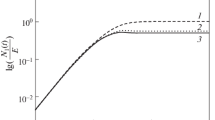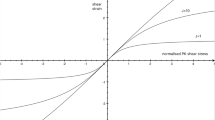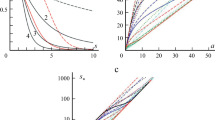Abstract
Based on the definitions of hardening, softening and ideal plastic behavior of elastic-plastic materials in the true stress tensor space, the phenomena of simple shear oscillation are shown to be relative to the oscillatory occurrence of hardening and softening behavior of elastic-plastic materials, namely the oscillation of hardening behavior, by analyzing a simple model of rigid-plastic materials with kinematical hardening under simple shear deformation. To make the models of elastic-plastic materials realistic, must be satisfied the following conditions: for any constitutive model, its response stresses to any continuous plastic deformation must be non-oscillatory, and there is no oscillation of hardening behavior during the plastic deformation.
Similar content being viewed by others
References
Agah-Tehrani A, Lee E H et al. The theory of elastic-plastic deformation of finite strain with induced anisotropy modeled as combined isotropic-kinematical hardening[J].J Mech Phys Solids, 1987,35(5):519–539.
Dienes J K. On the analysis of rotation and stress rate in deforming bodies[J].Acta Mech, 1979,32(3–4):217–232.
Szabo L, Balla M. Comparison of some stress rates[J].Int J Solids Struct, 1989,25(3): 279–297.
Chen Liangsen, Zhao Xinghua. The theory of materials with elastic range and the definition of back stress[J].Applied Mathematics and Mechanics (English Edition), 1999,20(5): 476–484.
Fu Minfu, Yang Deping, Huang Mojia.Finite Deformation, Fuzzy, Damage and Elastoplasticity[M]. Beijing: The Aerospace Industry Press, 1995, 20–21. (in Chinese)
Casey J, Naghdi P M. Further constitutive results in finite plasticity[J].Q J Mech Appl Math, 1984,37(2):231–259.
Casey J, Naghdi P M. On the relationship between the Eulerian and Lagrangian description of finite rigid plasticity[J].Arch Rational Mech Anal, 1988,102(4):351–375.
Nagtegaal J C, De Jong J E. Some aspects of nonisotropic work hardening in finite strain plasticity[A]. In:Proc Workshop on Plasticity of Metals at Finite Strain [C]. Div Appl Mech Stanford University, 1982, 56–106.
Nemat-Nasser S. On finite plastic flow of crystalline solids and geomaterials[J].J Appl Mech, 1983,50(4b):1114–1126.
Author information
Authors and Affiliations
Rights and permissions
About this article
Cite this article
Liangsen, C., Xinghua, Z. & Minfu, F. The simple shear oscillation and the restrictions to elastic-plastic constitutive relations. Appl Math Mech 20, 593–603 (1999). https://doi.org/10.1007/BF02464931
Received:
Issue Date:
DOI: https://doi.org/10.1007/BF02464931




